_We may earn revenue from the products available on this page and participate in affiliate programs. Learn more ›
_
Best Overall
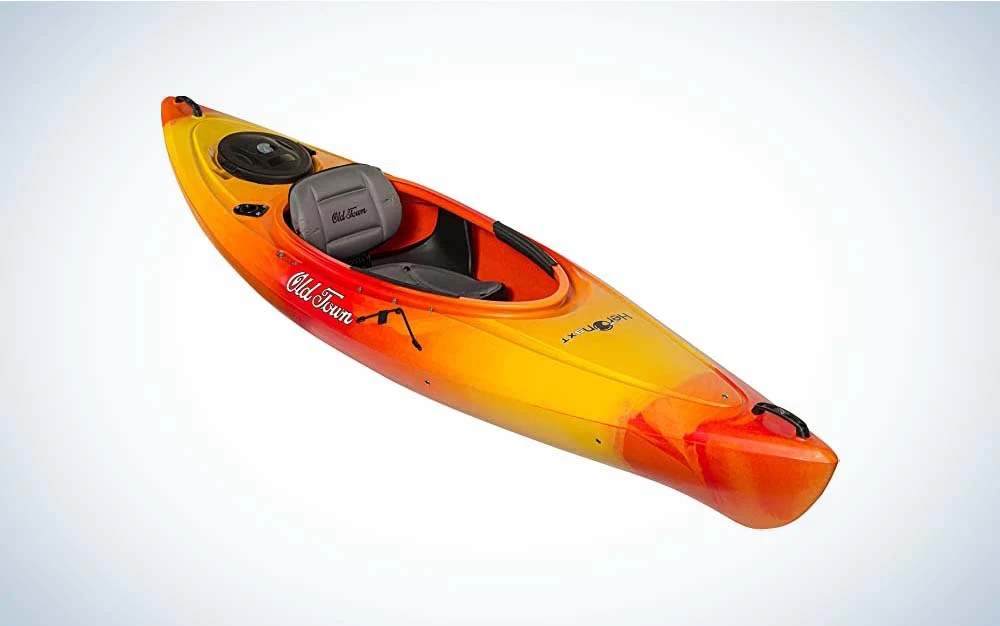
Old Town Heron 9 Kayak
LEARN MORE
Summary
The Old Town Heron 9XT is the best overall beginner kayak for its versatility, ease of transport, and affordable price.
Best for Fishing
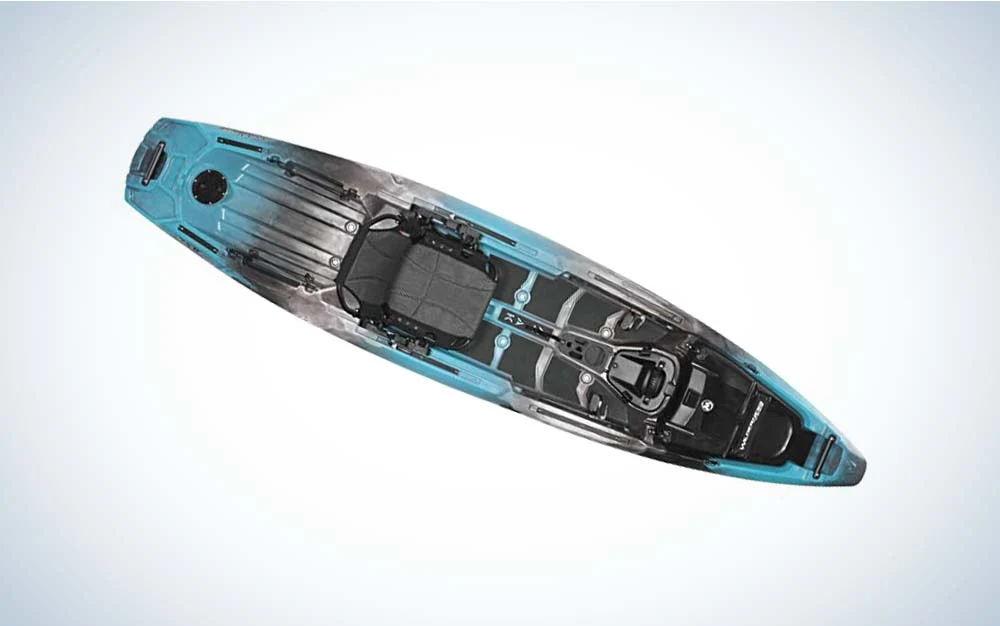
Wilderness Systems ATAK 120
LEARN MORE
Summary
The Wilderness Systems ATAK 140 kayak is a functional kayak for fishing with plenty of storage space and adequate comfort for all day on the water.
Best for Rivers
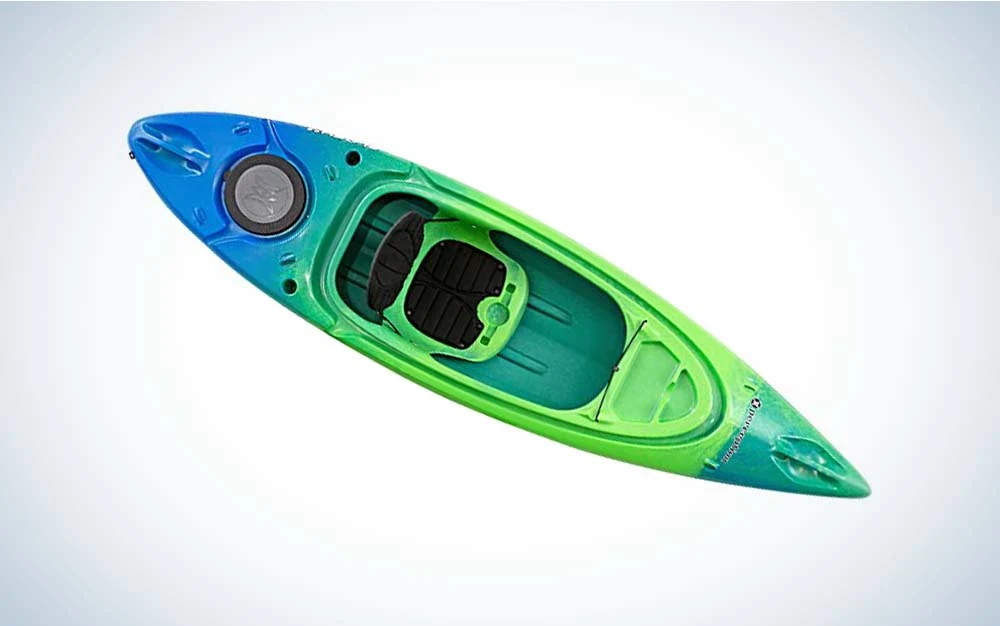
Perception Flash 9.5
LEARN MORE
Summary
The Perception Flash 9.5 is a functional and affordable beginner river boat that tracks well on flat water and can perform decently in low-level rapids.
Choosing from the wide range of kayaks for beginners can feel overwhelming. It is easy to run over to the local sporting goods store or hop online to find the cheapest options. But the cheapest kayak may not be the best fit, even for a beginner. Sure, we all have varying budgets, but jumping right for the lowest price can mean low quality and a poor-performing kayak that may hinder your overall kayaking experience.
Doing some back-end research and reflecting on your needs can help you find the right kayak for you. While you can always upgrade as you advance or change your interests, it often works best to get a versatile one right away. That way, you can learn and grow in the sport without having to buy multiple boats. Even if you didn’t find the right fit on our list of the best kayaks for beginners, use the buying guide below to help you narrow down your options.
Best Overall: Old Town Heron 9XT
Best for Lakes: Eddyline Sandpiper
Best for Fishing: Wilderness Systems ATAK 140
Best for Rivers: Perception Flash 9.5
Best Sea Kayak: Perception Expression 15
Best for Dogs: Pelican Sentinel 100X
How We Picked The Best Kayaks for Beginners
You may notice that we did not feature any inflatable kayaks in our top picks for the best beginner kayaks. Inflatable kayaks are an excellent choice for beginners that have limited storage space or if they want an inflatable whitewater Duckee. However, inflatables are generally not the best option for performance or longevity reasons. Several inflatable kayaks will perform fairly well, and they may be the right fit for your lifestyle and kayaking experiences.
Other considerations we used to choose the best kayaks for beginners include:
Durability: Durability should be a top priority, no matter the type of gear. For kayaks, this can be tricky because a lot of that comes down to how often you use them, how it is stored, and how you handle them. Look for products that have verified durability claims, lifetime warranties, repair policies, and a reliable track record.
Versatility: As a beginner kayaker, it is ideal to have a kayak that can introduce you to various types of water. Most beginner kayaks are best suited for calm waters, but some can be used on slow-moving rivers or coastal waters
.
Customer Service: Companies that value their customer experience while they are shopping, while they’re using the products, and if there are any issues are often the ones that genuinely believe in their equipment and designs.
Personal experience with products, company-specific research, and verified customer reviews were also used to narrow down the products included in this review.
The Best Kayaks for Beginners: Reviews & Recommendations
Best Overall: Old Town Heron 9XT
Best Overall
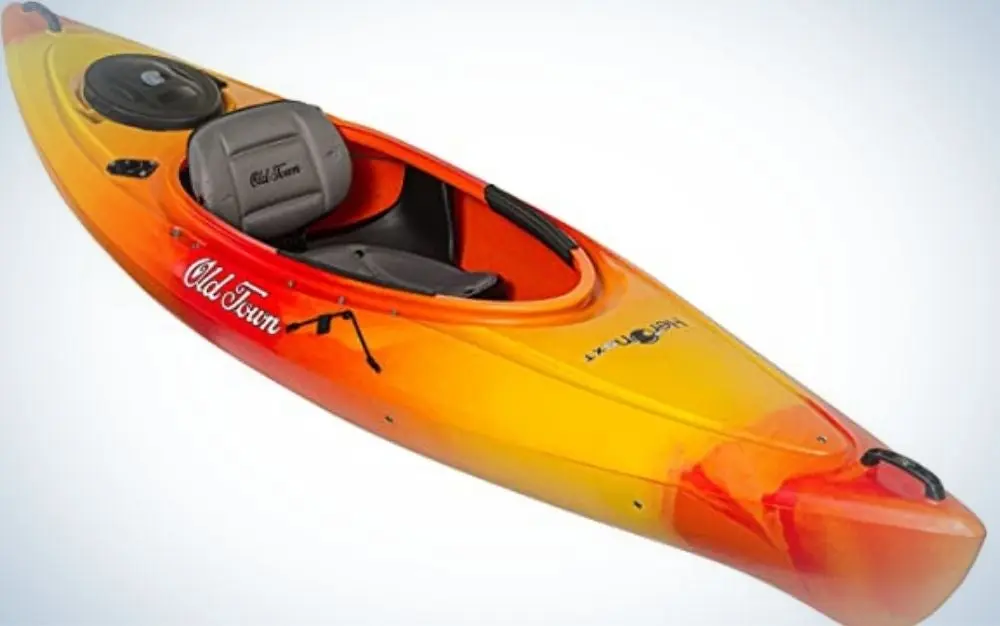
Why It Made The Cut: The Old Town Heron 9XT is the best overall beginner kayak for its versatility, ease of transport, and affordable price.
Key Features
Length: 9 ft 6 in | 2.9 m
Width: 28.5 in | 72.4 cm
Weight: 37 lbs
Best Use: Slow rivers, flatwater, fishing
Pros
Roomy cockpit
Versatile enough for fishing
Adjustable
Easy to carry
Cons
Doesn’t track as well as higher-end models
The Old Town Heron 9XT is one of the best beginner kayaks picks because of the overall value. It is an affordable option that provides a high level of versatility, allowing paddlers to enjoy lakes and slow-moving rivers. The cockpit, adjustable seat, and bracing system are pretty comfortable for the average person. If you are taller, you may want to test it out in person to see if you will be comfortable during long days paddling.
Compared to more expensive options, the Old Town Heron 9XT will not perform as well and has noticeably different tracking abilities. Many beginners may not notice this as they get used to kayaking, but some may find greater difficulty keeping the kayak straight as the paddle.
If you are just looking to try out kayaking and want an equally affordable and versatile option, the Heron 9XT is still excellent. Among the many features, there are two flush-mount rod holders and a paddle keeper to make fishing easier.
Best for Lakes: Eddyline Sandpiper
Best for Lakes

Why It Made The Cut: The Eddyline Sandpiper is great for kayakers that want to enjoy a chill day on the water while still having a high-quality performance.
Key Features
Length: 12 ft | 3.7 m
Width: 28 in / 71 cm
Weight: 38 lbs
Best Use: Flatwater, rivers class I-II
Pros
Great stability
Large cockpit
Easy access to storage
Excellent tracking
Cons
Higher price
If you’re willing to spend a bit more money and stick to calmer waters, the Eddyline Sandpiper should be your top pick. The features allow maximum buoyancy and more than adequate tracking to make paddling a breeze. While there are already several notable features, there’s also an assortment of accessories you can add to make your paddling experience even better.
There are deck fittings to store some items on the outside of the kayak, but there is also ample storage space. Two round hatches allow you to take small items in and out without digging through all of your gear to make it easier to access your stored items.
It is a very lightweight kayak, and most people can move it around independently. The retractable handles will also help with this. Since it is light, don’t expect handling to be excellent in choppy water or overly windy weather. It can handle small waves, but it functions better in calmer waters.
Best for Fishing: Wilderness Systems ATAK 140
Best for Fishing
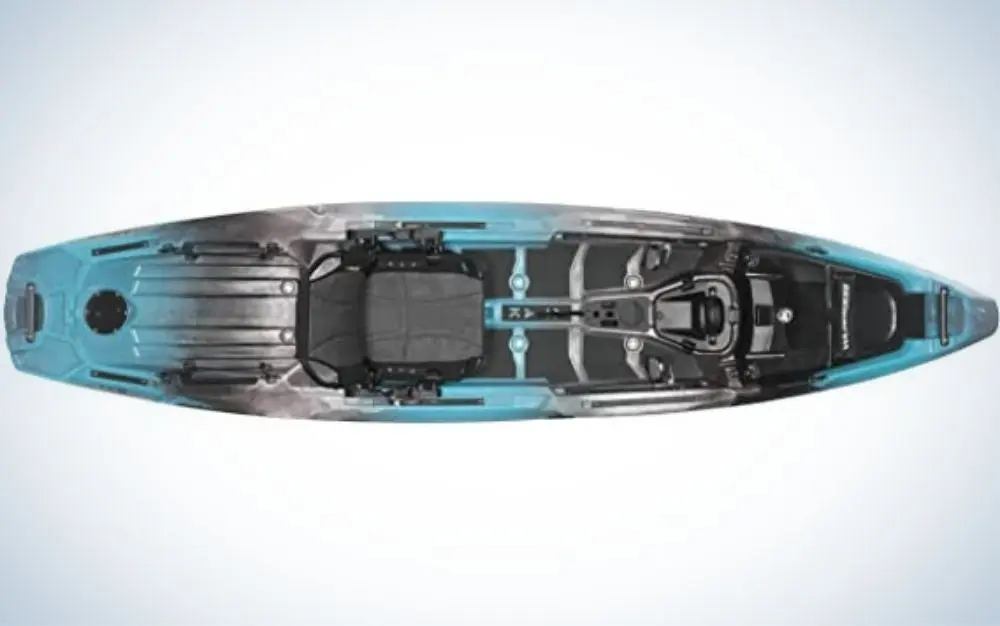
Why It Made The Cut: The Wilderness Systems ATAK 140 kayak is a functional kayak for fishing with plenty of storage space and adequate comfort for all day on the water.
Key Features
Length: 14 ft 1 in | 4.3 m
Width: 34 in | 86 cm
Weight: 95 lbs
Best Use: fishing
Pros
Storage space
Adjustable seat
Easy to maneuver and paddle
Customizable platform
Cons
Heavy
Hard to open the center hatch on the water
The Wilderness Systems ATAK 140 is an angler’s dream. It has all most anglers need right off the bat, but there are also some fantastic accessory options like the Helix MDM Motor Drive
for days you don’t feel like paddling or need to cover more distance.
Although it is a heavy kayak, the various carrying handles make moving it manageable. There is plenty of storage, so you won’t have to worry about leaving any of your gear behind. The center storage compartment can hold a lot, but it is hard to open when you are sitting on the water.
It is a larger kayak, providing a very comfortable fishing experience. The seat can be put into several positions to avoid a sore back after a day on the water. It may be a fairly large kayak, but it is still easy to maneuver, even in moving water. It works best on flat water but can do well in slow-moving rivers.
If you’re looking for more beginner fishing kayaks, be sure to review our roundup of the best fishing kayaks under $1000
. We also have individual reviews of many top-of-the-line fishing kayaks, including the Vibe Shearwater 125
, and the Hobie Pro Angler 12
.
Best for Rivers: Perception Flash 9.5
Best for Rivers

Why It Made The Cut: The Perception Flash 9.5 is a functional and affordable beginner river boat that tracks well on flat water and can perform decently in low-level rapids.
Key Features
Length: 9 ft 6 in | 2.9 m
Width: 28.5 in | 72.4 cm
Weight: 41 lbs
Best Use: Flatwater, slow-moving rivers, coasts
Pros
Affordable
Great stability
Excellent tracking
Easy to maneuver
Cons
Not comfortable for long days on the water
The Perception Flash 9.5 is a decent river kayak, especially for beginners that only plan to tackle slower-moving rivers. It is affordable and provides the value most beginners are looking for in a kayak, along with some versatility.
It is easy to transport and is a wonderful size to provide room to adjust in the cockpit (maybe fit a small dog) and plenty of additional storage in the back. While the seats are cushioned, they are not very comfortable. So, if you plan to try and use this kayak for longer-distance travel or even for a long day of fishing, you likely won’t be very comfortable by the end of the day.
For the price, it performs very well in the water, and it is easy to maneuver in a variety of conditions. As mentioned, this is a recommendation for beginners. If you are looking for a kayak that you can use strictly for whitewater, you may want to look elsewhere.
Best Sea Kayak: Perception Expression 15
Best Sea Kayak
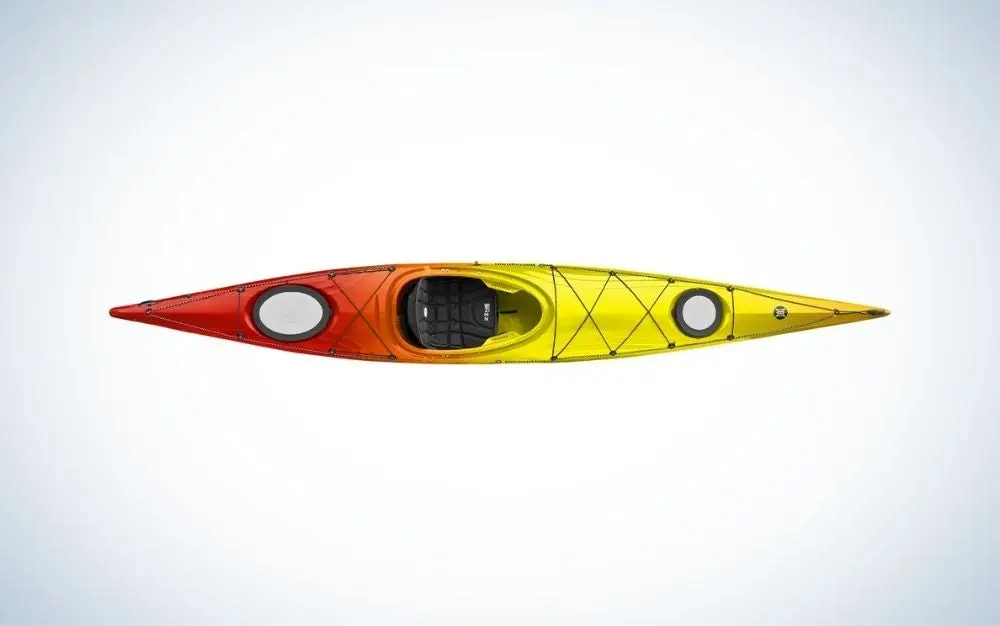
Why It Made The Cut: The Perception Expression 15 is a graceful touring kayak that you can grow with and hone paddling your skills.
Key Features
Length: 15 ft | 4.6 m
Width: 24 in | 61 cm
Weight: 57 lbs
Best Use: Recreational, calm coast, open ocean
Pros
Ergonomic cockpit
Stable paddling
Spacious cockpit
Generous storage
Cons
Difficult to transport and store
For recreational kayakers that want to explore the joys of open water paddling either on the coasts or out in the ocean, the Perception Expression 15 is a high-quality purchase. It is a high-performing kayak on lakes, ponds, calm coasts, and open oceans. It can handle some ocean surf but avoid using this kayak in rivers and streams.
The large cockpit makes it easy to get in and out of the kayak and allows a spacious area to sit while you paddle. An adjustable premium seat provides a comfortable experience even on longer excursions or tours.
While there is plenty of storage space in the front and the back, there are also cargo bungee cord lashes available for the gear you want easy access to as you paddle. Even when carrying a heavy load, the handling of this kayak is not sacrificed. The main downfall of this kayak is the same as any other touring kayak because it is hard to transport and store because of the long length.
Best for Dogs: Pelican Sentinel 100X
Best for Dogs

Why It Made The Cut: The Pelican Sentinel 100X kayak is a roomy sit on top kayak stable enough to hold you and your canine companion as you paddle.
Key Features
Length: 9 ft 6 in | 2.9 m
Width: 30 in | 76.2 cm
Weight: 42 lbs
Best Use: Recreational kayaking, fishing
Pros
Affordable
Stable
Ample storage
Relatively lightweight
Cons
Only recommended on calm waters
The Pelican Sentinel 100X kayak is a great beginner kayak whether you decide to bring your dog along for the ride or not. Sit on top kayaks often provide more space for an animal companion to ride along, and this model is stable enough to allow for some movement aboard without issue.
It is relatively lightweight and has handles on the ends and sides to make it easier to transport. If you are looking for a kayak that can also function for fishing, they make an angler-specific version of this kayak.
Although it is a sit on top, there is still plenty of storage. There’s a removable storage compartment and bungee cords for easy access to storage. The primary complaint of many customers is that when they order from Amazon, their kayak was damaged during shipping.
Things to Consider Before Buying The Best Kayaks for Beginners
How do you know which are the best kayaks for a beginner? You can check out any of our top picks, but first, we always recommend a few buying considerations.
Intended Use
The type of kayaking you plan to do will significantly influence which kayak is the best for you. Are you looking for a kayak to take on lake outings and fishing? Or are you planning to work your way up to whitewater kayaking?
Knowing the type of kayak that best suits your interests is a perfect place to start. You can identify other things like the frequency of use, how much storage space you have, and how you plan to transport the kayak from place to place.
Type of Kayak
The intended use of the kayak is directly tied to the type of kayak. There are two primary categories of kayaks: flatwater and whitewater.
Within each category, there are other more specific types of kayaks.
Flatwater Kayaks
Flatwater kayaks are what they sound like and are built for calmer waters. When talking about flatwater kayaks, we can break them down into five primary types:
Recreational Kayaks: Generally, sit-in kayaks or recreational kayaks have closed cockpits. The opening will be relatively large and comfortable for getting in and out of the water. It allows for a spray skirt, but one is not necessary, especially in warm weather. Recreational kayaks are around 10 feet or less, making them longer than standard whitewater boats but shorter than touring kayaks. The length makes them easy to transport, but they will not track (go straight) as easily as longer kayaks.
Touring Kayaks: A longer and narrower kayak, touring kayaks or sea kayaks have a small cockpit area and are equipped with thigh braces. Touring kayaks are generally 12 feet or more in length to improve tracking and add more space for gear. Since they are such long kayaks, they may also be equipped with a rudder to make it easier to turn. These are built for long-distance travel but aren’t the easiest to transport because of the length.
Sit-On Kayaks: A very approachable beginner kayak type is the sit-on-top style kayak. (Check out our roundup of the best sit-on-top kayaks
for examples.) These have an open cockpit and are similar to stand-up paddleboards in that you sit on them and store the gear on top as well. (Take a look at our list of the top inflatable paddleboards
for a different paddling experience.) These are popular for activities like fishing because it allows for easy access to your gear. The main disadvantage of sit-on-top kayaks is that you are more likely to get wet. This can be an advantage in warm weather, but make sure your gear is packed appropriately.
Pedaling Kayaks: Pedaling kayaks either have a propeller or flippers that you can use to help move forward as you pedal. These are a great option if you don’t have the strength to paddle or a condition that doesn’t allow you to use your arms in a paddling motion. Some anglers prefer the pedaling kayaks to keep their hands free. You can still use a paddle with pedal kayaks, but it isn’t required since your legs can do the work. Since these are a bit more complex, they tend to be more expensive. For an extensive list of the best pedal kayaks
, check out our expert recommendations.
Inflatable Kayaks: Inflatable kayaks are gaining popularity as they are a more portable option that is easy to store. They do not last as long, will not track as well, and are far less comfortable on the water than other types of kayaks, but they do the job if you want a chill day on the water.
Another portable option is a foldable kayak. These are very lightweight and easy to transport. They won’t be as durable as the folding creates seams in the kayak, but they’re easy to use, transport, store, and often perform far better than inflatable options.
Flatwater kayak types all have their advantages. Narrowing down the type of flatwater kayak will come down to your intended use, storage space, and portability.
Whitewater Kayaks
Whitewater kayaks have five commonly distinguished types:
River Runners: A comfortable kayak option, river runners are around 7-8 feet long. They work well in slow, flat areas of the river and are still short enough to be easy to maneuver and make tight turns. Most river runners have plenty of gear storage and can hold gear for a multi-day trip.
Creek boats: Also known as “creekers,” creek boats are at least 8 feet or longer. These are very durable boats, but they are not the best for beginners. Many creek boats have a displacement hull to help with drops but can be challenging to maneuver when crossing eddy lines or holes. Beginners will benefit more from a planning hull as it handles better in various water conditions. Overall, these boats are comfortable but will be heavier than a river runner in most cases.
Playboats: Not recommended for beginner kayakers, playboats are designed for “playing” in standing waves or holes. They are not great for traveling down a river from point to point. These kayaks will be around 6 feet long and are an excellent trick boat. Most paddlers find playboats to be relatively uncomfortable and take time to get the hang of as the kayak and paddler need to work in unison.
Old School: Also known as “longboats,” these will be a common find when looking at used kayaks and will be fairly affordable for a complete setup (kayak, paddle, and skirt). Old school kayaks of this style were produced in the late 80s-early 90s and are around 10-12 feet long. If you want a boat capable of tracking on flat water and some rapids, these can be an excellent choice. You may run into issues when trying to turn quickly because of the length. Compared to more modern whitewater boats, they also aren’t quite as comfortable and have smaller cockpits. Larger cockpits are nicer for the paddler and serve as a safety component to make it easier to escape if flipped over.
Inflatables (Duckies): Inflatable Whitewater Kayaks are excellent for beginners. Most Duckies are wide, making them nice and stable and able to haul plenty of gear. The only major disadvantage is that they are harder to make tight turns. Overall, they are a comfortable and approachable kayak for beginners wanting to test out whitewater.
These are not all of the types of whitewater options. The five listed here are the most common, but there are several hybrids also available.
Make sure you’re prepared before hitting the river. A good start is reading these guidelines from American Whitewater
.
Durability
How long a kayak lasts has a lot to do with the overall quality, frequency of use, and how it is stored. For most beginners, buying a used kayak will be the most affordable and best value option. But many beginners also gravitate toward inflatable sit-on kayaks. While these are an affordable and easy-to-store option, they are not the most practical for long-lasting use.
Since they are inflatable, they are prone to leaks and punctures, whereas a solid kayak can still have faults, but it is much harder to get to that place. Although you can make some pretty good assumptions about the quality of a kayak based on online research, an excellent way to start is to talk to more experienced kayakers.
In most cases, these kayakers have had a few different boats and can give a realistic view of how durable they really are and how well they perform. If you don’t know anyone who kayaks, you can join online forums, go to local gear shops or outfitters, or even stop by the popular paddling spots and strike up a conversation.
Portability
How you transport and store your kayak can significantly impact the type of kayak you buy. One of the primary reasons that so many beginners get inflatable kayaks is that they don’t have a roof rack or don’t have storage space at home.
The type of kayaking you want to do can influence this too. Most whitewater kayaks are smaller and easier to store than recreational or touring kayaks, but that isn’t always the first place someone just getting into kayaking wants to begin.
Take stock of the size and weight of your kayak when shopping. You will need to have a way to get it from your home to the paddling destination, so have a good understanding of your physical limits. Can you lift it onto the top of your car? Do you have a truck to make things easier for loading and unloading?
Be realistic with the purchase and how much space you have available to store the kayak and how you plan to transport it.
FAQs
Q: What kind of kayak is best for beginners?
The kind of kayak best for beginners is often one that is durable, stable, and versatile. If you are looking to get into a specific type of kayaking, then the kind of kayak best suited for your needs will vary. Use the buying guide at the beginning of this article for tips on narrowing down the type of kayak that will work best for you.
Q: Is a sit-in kayak better for beginners?
A sit-in kayak can work for beginners and is more efficient when paddling since you have a lower center of gravity. However, sit-on kayaks tend to be more approachable for beginners as they feel less confining and have no leg braces or spray skirts. Either option can work, but it will depend on the type of kayaking you’d like to pursue.
Q: How much should I spend on my first kayak?
Your budget should determine how much you should spend on your first kayak. The good news is that if you are on a tight budget, you can still find affordable, high-quality used kayaks or rent them a few times. There isn’t a right or wrong answer to this question. It all comes down to your financial situation.
Q: What is more stable a sit-on or sit-in kayak?
Sit-on kayaks provide a good level of stability, and many beginners find them easier to use. Sit-on kayaks are often used as recreational kayaks for still water paddling and fishing because of their stability. Sit-in kayaks are built more for efficiency while paddling and will be easier to maneuver in the water.
Q: Do kayaks flip easily?
Kayaks don’t flip over all that easily, but it can happen. The risk is much higher when paddling through rapids or fast water. As a beginner, it is best to start paddling on still water and work your way up. Learn what to do if the boat does flip so you can safely flip it back over or escape.
Final Thoughts on the Best Kayaks for Beginners
The best kayaks for beginners is a tricky topic to narrow down. The type of kayaking you intend to pursue is the first place to start, and then consider your budget. Although there are several amazing new options, one great way to get started in paddling is to borrow equipment, rent it, or buy used. All of these give you a chance to try out the sport without feeling like you need to buy everything new. Plus, they’re the most affordable and sustainable options as well.
Why Trust Us
For more than 125 years, Field & Stream has been providing readers with honest and authentic coverage of outdoor gear. Our writers and editors eat, sleep, and breathe the outdoors, and that passion comes through in our product reviews. You can count on F&S to keep you up to date on the best new gear. And when we write about a product—whether it’s a bass lure or a backpack—we cover the good and the bad, so you know exactly what to expect before you decide to make a purchase.
![Field & Stream [dev]](https://images.ctfassets.net/fbkgl98xrr9f/1GnddAVcyeew2hQvUmrFpw/e4ca91baa53a1ecd66f76b1ef472932b/mob-logo.svg)





